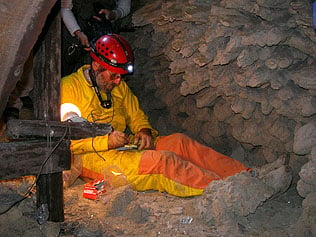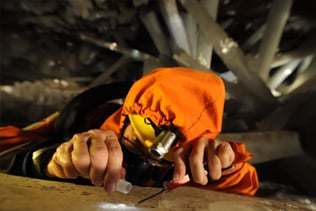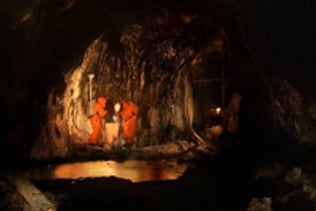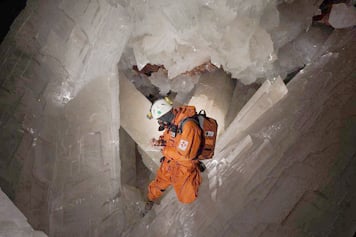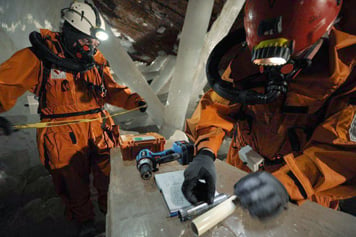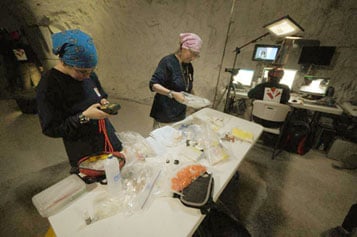NAICA PROJECT – SCIENTIFIC RESEARCH
NAICA PROJECT
SCIENTIFIC REPORT RESEARCH REPORT
(G. BADINO AND P. FORTI) Below is a summary of the main objectives of each research group involved in the NAICA Project and the progress achieved to date.
Regional Geology
Person in charge: Leonardo Piccini (University of Florence), (leonardo.piccini@unifi.it)
Participants: Italo Giulivo (La Venta)
Marco Mecchia (La Venta)
Francesco Sauro (University of Padua)
Roberta Tedeschi (La Venta, VirtualGeo)
Objective: The objective of this group is not to conduct experimental research, but to provide a clear, accurate description of the geological and geo-morphological conditions of the NAICA area, which constitutes the basis of the studies of the other research groups.
State of the research: All the available bibliographical information at both university libraries and on the WEB has been compiled. The vast amount of information provided by the NAICA Mine Geology Office has been crucial. All the material has been compiled, meaning that the research group's work will be completed in the course of 2009.
Hydrogeology
Person in charge: Italo Giulivo (La Venta), (italogiulivo@tin.it)
Participants:Giovanni Badino (University of Turin)
Marco Mecchia (La Venta)
Leonardo Piccini (University of Florence),
Francesco Sauro (University of Padua)
Objective: The objective of this research is to reconstruct the evolution of the thermal aquifer both in the past and during the stages after it was disturbed during to the mining work, in order to incorporate the results obtained into those from the studies on the caves' speleogenesis and mineral genesis.
State of the research: At the regional level, all the data available both on the WEB and in the bibliography have been compiled. The data provided by the NAICA Mine Geological Office on the evolution of mining extraction during the last half century have proved extremely useful. Aquifer models have begun to be designed to evaluate the recharging areas and the time the waters remain inside, which, according to isotopic data, appears to be very long. The most difficult aspect of this task is the fact that there are no data on the loss of water by the system beyond that caused by the mining activity.
Mineralogy
Person in charge: Antonio Rossi (University of Modena), (antoross@unimore.it)
Participants:Ermanno Galli (University of Modena)
Paolo Forti (University of Bologna)
Objective: The objective of the research is to identify the various mineralogical phases present together with the plaster and to define the genetic processes for providing a detailed reconstruction of the minerogenetic evolution of the NAICA caves.
State of the research: The experimental phase of the research began in May 2006 when the first samples were sent to the University of Bologna. During this period, studies and analyses were carried out of the plaster crystals and other neoformation minerals using an optic microscope, electronic microscope and a semiquantitative probe (EDAX). On the following trips, sample collections were compiled on the basis of the results of the analyses. This group’s work is now at an advanced stage and has led to the publication of several international articles (see Bibliography).
The main results obtained can be summarized as follows:
1- A completely new form of plaster, restricted to the Candle Cave, has been discovered. Its evolution is associated with the beginning of the artificial deepening of the side of the mine to -290. It is made up of crystalline shapes that evolved in a few days or months twenty years ago when water was pumped out of the caves.
2- A difference in structure and composition has been observed between the plaster in the Sword Cave and that of all the other caves at a depth of -290. These differences are due to the fact that the Sword Cave was formed exactly at the epiphreatic level, whereas the others were created at the deep phreatic level. The study of these differences, together with other studies (pollen, fluid inclusions, absolute dating) permit a detailed reconstruction of the thermal aquifer over the past thousands of years.
3-A detailed mineralogical study has been conducted of the existing solid inclusions inside the plaster crystals, as well as of the deposits under them, and also of those that began to be formed about twenty years ago, when the caves were drained. Forty-one neoformation crystals have been observed, nine of which (antlerite, cu-prentaidrite, hectorite, orientite, plumbojarosite, starkeyite, szmolnokite, szmikite and woodruffite) are totally new for the cave environment.
Researchers have identified the minerogenetic mechanisms and the depositional sequence of all the minerals. The studies are now focusing on the impurities present in the plaster crystals in the Sword Cave where a mineral previously unknown to science has been found. It is a magnesium and zinc silicate that is being studied to determine its mineralogical and crystallographic features.
Absolute Datings
Person in charge: Stein Erik Lauritzen (University of Bergen, Norway), (stein.lauritzen@geo.uib.no)
Participants:José María Calaforra Chordi (University of Almería, Spain)
Paolo Forti (University of Bologna)
Objective: This is a crucial research project to determine when the crystals were formed and in how much time to contribute to the time reconstruction of the evolution of the NAICA thermal aquifer. The U/Th method will be used to date progressively deeper crystals to determine not only the absolute age of the larger crystals but also to discover variations in the speed of growth over time.
State of the research: A trial dating has been carried out that has theoretically proved the possibility of carrying out this dating, although the amount of uranium is very low. The first dating carried out 5 cm below the surface of a crystal fragment of the Crystal Cave has yielded an age of 34,5 Myr/BP. On the basis of this data, one can reasonably assume that the larger crystals must be several hundred thousand years old. A sampling has also been carried out of a fragment of a larger crystal that is currently being studied at an Oslo laboratory and from which two dates have been obtained that appear to confirm the first data obtained.
Sampling was also carried out on the access wall to the Queen's Eye (where there is a sequence of macro-crystalline plaster measuring over 2.5 meters) in which three different black levels have been observed that appear to indicate temporary interruptions in the depositing of the plaster and the rusting of the deposits. This sequence will be dated to reconstruct the speleogenetic evolution of the area.
The over fifty U/Th analyses will be completed in the course of 2009.
Crystallography
Person in charge: Eugenio Scandale (University of Bari), (scandale@geomin.uniba.it)
Participants:Nicola Melone (University of Bari), (n.melone@geomin.uniba.it)
Objective: The research seeks to determine the characteristics of the plaster crystals in order to understand its growth mechanisms better.
State of the Research: The researchers are currently reconstructing the history of the growth and evolution of the smallest crystals (Sword Cave) through the characterization of the structural flaws, analyzed through RX topography in diffraction RX topography. To this end, various sections have been made, with a thickness of ca. 0,5- 0,6 mm, parallel and perpendicular to the growth axis. The sections on both faces have been polished to permit analysis with RX topography. Preliminary results indicate that during the first stage of growth, crystals develop in an 001 direction as an effect of germination, whereas lateral growth successively takes place through a process of screw dislocation parallel to direction 100, in other words, through the success superimposition of epitaxial layers.
Speleogenesis
Person in charge: Paolo Forti (Universidad de Bologna), (paolo.forti@unibo.it)
Participants:José María Calaforra Chordi (University of Almería, Spain)
Stein Erick Lauritzen (University of Bergen, Norway)
Leonardo Piccini (University of Florence),
Objective: The objective of the research is to provide a detailed description of the mechanisms that have permitted the evolution of the NAICA caves from the outset until their current shape, including the chemical deposits contained in them.
State of the Research: From the speleogenetic point of view, it has been observed that although all the caves developed inside the same thermal aquifer and therefore through theoretically identical processes, each one has unique characteristics that are different from the rest, due to local factors. In order to arrive at a univocal definition of the speleogenetic mechanisms that acted inside the NAICA sierra, the evolution of each cave has had to be analyzed separately. The two mechanisms through which the caves were formed and the four principal mechanisms that led to the evolution of the plaster crystals have already been determined. A detailed study of the chemical deposits of each cave has made it possible to reconstruct the speleogenetic evolution of all the NAICA caves. The study will be published in 2009.
Fluid Inclusions
Person in charge: Paolo Garofalo (University of Bologna), (paolo.garofalo@unibo.it)
Participants:Paolo Forti (University of Bologna)
Detlef Günther (ETH Zurich, Switzerland)
Objective: The study seeks to determine the temperature at which the plaster crystals were formed and to define the physical and chemical properties of the fluids that produced them. These data are crucial to the reconstruction of the evolution over time of NAICA's thermal aquifer and, together with the absolute dating and palynology data, will also contribute to the paleoenvironmental and paleoclimatic reconstruction of the NAICA area.
State of the Research: A few hundred fluid inclusions contained in the crystals from the Sword, Queen's Eye and crystal caves and in the experimental laboratory at level -590 of the mine were studied. The preliminary results of this research, which have already been presented at national and international congresses (see Bibliography), have shown that, contrary to what was originally believed, the fluids' salinity varies throughout the crystal deposits (from ca. 3.5 to 7.5 NaCl wt% equivalent). Moreover, the temperature of the deposits was not constant, and varied from cave to cave (from 51ºC to 57ºC). In 2008, samples of fluid inclusions were analyzed using the ICP-MS Laser Ablation Technique at the Chemistry Department of the Federal Polytechnic in Zurich, Switzerland. The results obtained were presented at national and international congresses and the final study will be ready by late 2009 or early 2010.
Experimental Laboratory
Person in charge: Francesco Lo Mastro (La Venta), (cicciolom@libero.it)
Participants:Paolo Forti (University of Bologna)
Objectives: An experimental laboratory has been set up at level -590 of the mine (the first level at which thermal water appears) to experimentally measure the speed of the annual growth of the NAICA plasters in similar conditions to those that existed before the mine's phreatic layer began to drop. This will permit an indirect confirmation of the age of the crystals in the caves and provide useful data for imagining conditions in the aquifer when mining activity ceases.
State of the Research: An instrument invented and produced at the University of Bologna was set up in the experimental laboratory. Twelve plaster plates and three limestone plates were deposited in it. Data on the natural plaster deposits are periodically controlled gravimetrically and the study will have a minimum duration of two to three years to collect data with minimum errors.
The first plates recovered show how the process of depositing plaster is totally different to that of the walls at level -590 and conversely, very similar to that of NAICA caves. The small plaster neoformation crystals are all parallel, meaning that in time, they will form a single monocrystal. The first data on the speed of growth suggest an age of several hundred thousand years for the large NAICA crystals, which tallies with the results of the absolute datings. The final results will be available in 2010.
Geochemistry
Person in charge: Juan Pablo Bernal (UNAM, Mexico)
Objectives: The objective of the research is to provide a geochemical and isotopic characterization of the waters that circulate in the mine to reconstruct the relationship between these waters, the mineralization and the caves.
State of the Research: The research project began in September 2007 with the collection of the first samples of waters and rocks inside the mine, in collaboration with the Geological Office of the mine.
Microbiology
Person in charge: Penelope Boston (New Mexico Tech, USA), (pboston@nmt.edu)
Participants:Diana Northup (University of New Mexico, USA)
Lisa Majkowski (New Mexico Tech, USA)
Paolo Forti (University of Bologna)
Objectives: The objective of the research is to determine whether microorganisms (extremophylls) were trapped in the NAICA crystals so that they can be identified and eventually have their DNA studied. Research is crucial to determining the role of microorganisms in the evolution of the NAICA crystals and mining deposits in general.
State of the Research: Preliminary research has shown that the fluid inclusions contain clear biogenic fossil forms, mainly in the form of hydroxide oxide hydrates of iron and magnesium. These solid inclusions have not preserved any recognizable organic matter in their interior from which DNA can be extracted. It was therefore decided to extract the liquid from certain fluid inclusions and subsequently proceed to carry out the necessary studies and analyses.
The research began in 2009 with the sending to Albuquerque, USA of crystal fragments taken from the Sword and Crystal Caves on the September 2007 expedition.
The water trapped in the fluid inclusions in the Crystal and Sword Caves has been placed in cultivation in both an aerobic and an anaerobic atmosphere. After 10 months, the researchers have confirmed that a biomass is effectively developing, but at an extremely slow rate, which is why DNA analyses will not be able to begin before 2010.
Final results are expected by mid-2010.
Palynology
Person in charge: Anna Maria Mercuri (University of Modena) (mercuri.annamaria@unimo.it)
Participants: Mara Loreti (University of Modena)
Carla Alberta Accorsi (Universidad de Modena)
Paolo Forti (University of Bologna)
Objective: The objective of the research is to verify the possibility that certain pollens are encapsulated inside the NAICA caves and its plaster crystals. Studying them could prove useful for reconstructing the paleoenvironment and the paleoclimates of the NAICA area in the remote past (in collaboration with studies on the fluid inclusions and absolute datings.)
State of the Research: In 2007, sediment at the bottom of the Sword Cave and crystals in the Sword and Crystal Caves began to be extracted. Small amounts of pollen have been found to exist (see Bibliography) Other samples of caves and the outside have been prepared that have served as the basis of the control required to define possible contamination of the samples removed from inside the mine.
In late 2008, over 60 pollinic granules were identified, proving that tens of thousands of years ago in NAICA there was a much more humid, cooler climate than there is today (similar to that of Los Angeles today). Once the results of the absolute datings are over (late 2009-early 2010) the final study will be drafted.
Preservation of the Caves
Person in charge: José María Calaforra Chordi (University of Almería, Spain), jmcalaforra@ual.es
Participants:Giovanni Badino (University of Turin)
Paolo Forti (University of Bologna)
Objectives: The objective of the research project is to determine the causes that are currently leading (or could lead in the future) to the environmental degradation of the caves in the NAICA mine and to find practical solutions that could reduce or eliminate the problem. Another aspect that will be considered concerns the possibility of visiting the giant crystals after the mine has completed its cycle.
State of the Research: Certain crucial data from these studies have been taken from the Climatology and Physics studies (see related paragraph) which have shown that the caves at level -290 of the mine are cooling relatively rapidly. A year ago, condensation began to occur in the smallest cavity (The Queen's Eye, current temperature, 41°C). In this cave, the generative processes of the plaster crystals experiencing condensation have been monitored. Although the Crystal Cave has yet to reach the point of condensation, this moment is approaching. Intervention is therefore required to minimize heat losses in its interior through hermetic doors. In this same cave, protected pathways must be built to prevent the crystals from being damaged- From a static point of view, however, the cave walls show no signs of instability.
A project will also have to be set up for the Sword Cave to enable the cave’s environment to be protected.
Further information is required to be able to proceed to the design of a definitive program.
Climate and Physics of the Caves
Person in charge: Giovanni Badino (University of Turin), (badino@to.infn.it)
Participants:José María Calaforra Chordi (University of Almería, Spain)
Italo Giulivo (La Venta)
Objectives: The extraction of the mineral permitted the discovery of the wonders of NAICA while creating an extremely different state to that of the equilibrium in which they were formed. Climate studies are seeking to analyze the current phenomenology to determine:
- The short and medium term temperature variations
- The humidity variations, particularly regarding possible condensation effects on the crystals
- The presence of thermal sedimentations in the cave
- Energy and fluid exchanges with the surrounding rock
- The possible presence and climate role of unknown branches
- The level of thermal connection with the exterior
- The reconstruction of the thermal history of the massif where the set of caves opens out, which is a crucial element in understanding their formation.
State of the Research: Following an isolated measurement in October 2002, systematic measurements began to be taken by a station that has obtained non-continuous time series since April 2006 through a network of thermometric sensors in the Crystal Cave and its surroundings.
In June 2006, the network expanded to another four groups of sensors to measure the humidity. The flow of air leaving the cave and motor pressure have also been measured. A small temperature monitoring station was set up in the experimental laboratory at level -590 of the mine.
The results have made it possible to reach the following preliminary conclusions: - The cave has slight thermal contact with the outside atmosphere, even with the doors closed.
- The sharp variations in relative humidity appear to be related to meteoric infiltration waters that may have come in through the NAICA fault.
- The cave has (unexplored) extensions in the surrounding rock, with a drop of tens of meters.
- The cave is cooling at a rate of 0.5 °C/a.
- Open doors create a flow of hotter, very humid air that throws its energy equilibrium off balance and may damage the crystals.
- Thermal sedimentation occurs in the cave. The first stage of measurements has been completed. Over the next few months, a new cave monitoring project will be carried out that will include an external station and stations at greater depths. Researchers will attempt to locate the historical thermal data on the mining excavation to reconstruct the evolution of the massif’s thermal exchanges.
Physiology
Person in charge: G.G. Hidalgo (Speleoresearch & Films, Mexico)
Participants: Giuseppe Giovine (La Venta), (yyoung@hotmail.it)
Objectives: The purpose of the studies is to determine the criteria that will guarantee the safest possible operations in external environments. The aim is to understand the peculiarities of the physiological reaction of the human body under these environmental conditions, paying particular attention to adaptive reactions.
State of the Research: To date, some of the explorers have undergone physiological monitoring. The measurements carried out before and after exposure to the extreme atmosphere have made it possible to define the safety parameters for working in the cave. Measurements have been taken of persons in conditions of sub-acute exposure and after training to adapt to specific temperature and humidity conditions.
In addition to the research work, an intervention protocol has been prepared for what to do in the event of an accident: communication, rescuing the injured person, transport system, rescue equipment and technical rescue materials.
Scanner Laser Survey
Person in charge: Roberta Tedeschi (Virtualgeo, La Venta), (robertatedeschi@yahoo.it)
Objectives: To construct a three-dimensional digital model of the NAICA caves that will make it possible to visualize the dimensions of the caves and the development of the crystals, permitting the geomorphological study of the caves without having to be physically inside them. The 3D digital model of the caves will be able to be used for dissemination to the public, for example, through the virtual and stereoscopic enjoyment of the caves. This will provide a possible solution to the conflict between the need to publicize the unique phenomenon of the NAICA caves and the restrictions imposed by the demands of conservation and environmental conditions.
State of the Research: Within the context of the analysis of the caves' topography, the intervention of Virtualgeo in NAICA, with the collaboration of Cam2_Faro has proved the feasibility of using laser scanning to survey the caves, particularly as regards the reaction of the transparent crystals to the laser impulse. In 2007, five scannings were carried out of the Sword and Crystal caves, which yielded spatial coordinates and an RGB chromatic value of over 47 million points.
Exploration and Surveys
Person in charge: Antonio De Vivo (La Venta), (tonodevivo@tin.it)
Participants: Giovanni Badino (University of Turin)
Tullio Bernabei (La Venta)
Italo Giulivo (La Venta)
Francesco Lo Mastro (La Venta)
Laura Sanna (University of Sasari)
Francesco Sauro (University of Padua)
Roberta Tedeschi (La Venta, VirtualGeo
Objectives: The objective is to complete the explorations of the inside of the caves in the NAICA massif and to conduct various types of topographical surveys.
State of the Research: The lower parts of the cave have been fully explored, although there are some doubts about the area in the East and the Northeast, from which an air flow appears to emerge.
Several instrumental survey operations have been carried out in the cave for a total of ca. 40 man hours of presence. The work carried out in 2008 has completed the survey of everything that has been explored.
To date, 217 m of principal polygonals have been recorded, in addition to a dozen meters of combined polygonals.
A systematic survey of each megacrystal has also been carried out. A total of 149 have been measured so far, accounting for 90% of the total.
Technique and Material
Person in charge: Giuseppe Casagnande (La Venta), (ca.giu@libero.it)
Participants: Giovanni Badino (University of Turin)
Francesco Lo Mastro (La Venta)
Mc Kay (NASA)
Objectives: The environmental conditions in the Crystal Cave are among the most hostile in the world. From the outset, the main problem has been to devise techniques, methods and materials to ensure survival during the time required for the research. To this end, we have employed techniques previously used for exploring thermal caves.
State of the Research: The work was completed with the fourth version of the Tolomea suits and the four Sinusit respirator suits (May 2007).
In 2008, the research team began collaborating with NASA to test miniaturized instruments that will be sent to Mars in NAICA. The first instrument to be tested was a Raman spectrometer with laser excitation that has worked superbly in the Crystal Cave and proved the possibility of non-destructive analyses in this environment.
|


